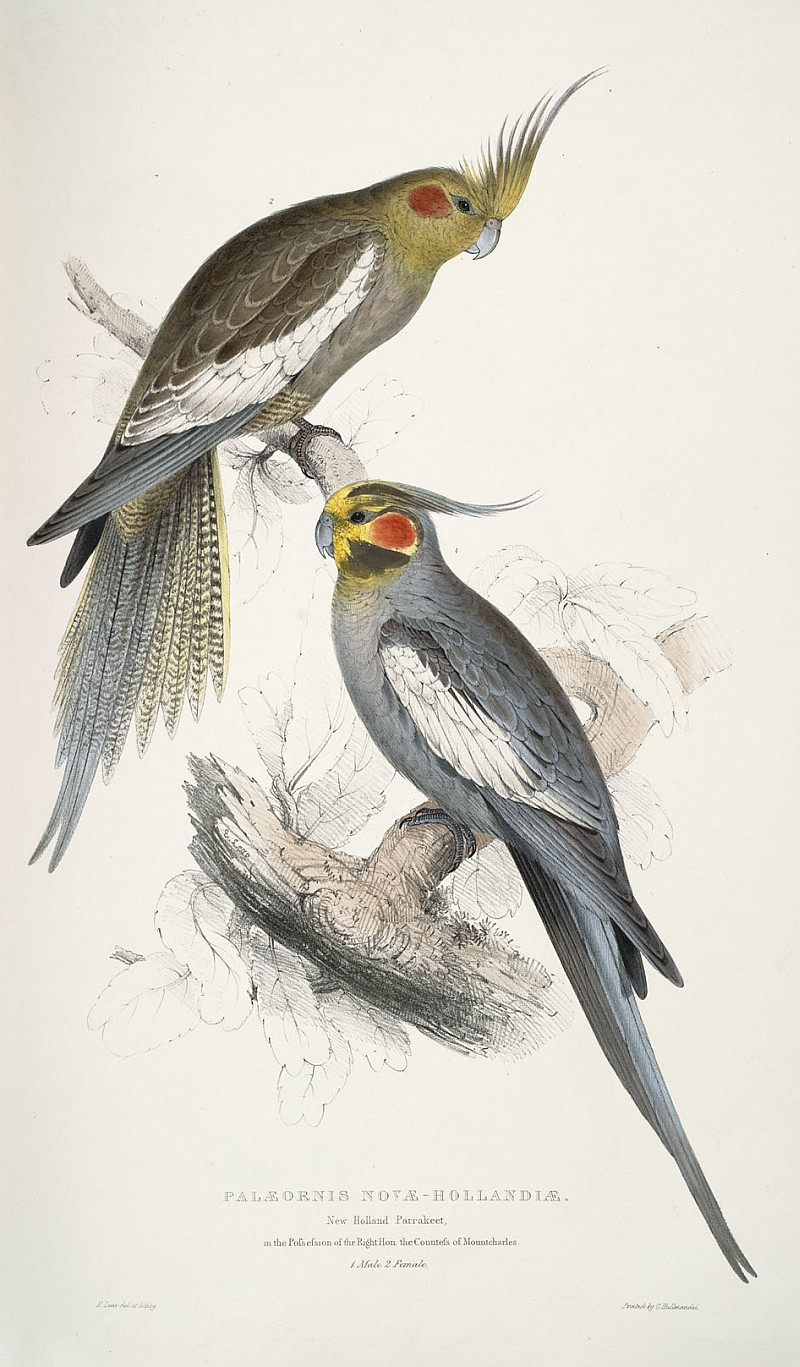Edward Lear
"Ilustraciones de la Familia Psittacidae, o Loros /
Illustrations of the Family of Psittacidae, or Parrots", 1832
Edward Lear (12 de mayo de 1812 - 29 de enero de 1888) fue un escritor, ilustrador y artista británico conocido por su poesía sin sentido y sus limericks (poesías humorísticas breves, de cinco líneas, en las que las dos primeras y la última riman).
Nació en Highgate, un suburbio de Londres, siendo el vigésimo hijo. Fue criado por una hermana veintidós años mayor que él. A la edad de 15 años, él y su hermana dejaron la casa familiar para independizarse.
Calyptorhynchus Baudinii
Prosopeia (ant. Platycercus) Tabuensis
Lear empezó a trabajar como ilustrador y su primera publicación fue "Illustrations of the Family of Psittacidae, or Parrots (Ilustraciones de la Familia Psittacidae, o Loros)" en 1832 ; 42 pinturas de loros en estampas litográficas presentadas como un libro que empezó a pintar con apenas 18 años. Se hicieron 175 copias de las cuales cerca de 100 llegaron hasta nuestros días. Pintó loros vivos en el Zoo de Londres y algunos de colecciones privadas. La calidad de sus pinturas de loros le granjearon una reputación como uno de los mejores artistas de historia natural de su tiempo; fueron comparadas incluso con las del naturalista John James Audubon.
Se pueden ver la totalidad de las láminas en Wikimedia Commons. Datos de la obra traducidos de aquí.
Cacatua moluccensis (ant. Plyctolophus rosaceus)
Lorius domicellus
Durante el resto de su vida realizó dibujos serios aunque se hizo famoso por sus obras humorísticas. En 1846 publicó A Book of Nonsense, un volumen de limericks que se reeditó tres veces y que ayudó a la popularización de este tipo de poesías. En 1865 publicó The History of the Seven Families of the Lake Pipple-Popple, y en 1867 publicó su más famosa obra absurda, The Owl And The Pussycat, que escribió para los hijos de su jefe, Edward Stanley, conde de Derby.
Lear nunca tuvo buena salud. Desde los 17 años hasta su muerte sufrió epilepsia (le grand mal) así como bronquitis, asma y, en la vejez, ceguera parcial.
Cyanoramphus (ant. Platycercus) unicolor
Platycercus icterotis (ant. Stanleyii)
Edward Lear (12 May 1812 – 29 January 1888) was an English artist, illustrator, author and poet, and is known now mostly for his literary nonsense in poetry and prose and especially his limericks, a form he popularised. His principal areas of work as an artist were threefold: as a draughtsman employed to illustrate birds and animals; making coloured drawings during his journeys, which he reworked later, sometimes as plates for his travel books; as a (minor) illustrator of Alfred Tennyson's poems. As an author, he is known principally for his popular nonsense works, which use real and invented English words.
Cacatua sulphurea (ant. Plyctolophus sulphureus)
Ara Macao (ant. Macrocercus Aracanga)
Nymphicus hollandicus (ant. Paleornis Novae-Hollandiae)
Lear's first publication, published when he was 19 years old, was Illustrations of the Family of Psittacidae, or Parrots in 1832; 42 paintings of parrots as lithographic plates bound together as a book. A total of 175 books were made of which about 100 survive today. He painted live parrots at the London Zoo and some in private collections. The quality of his paintings of parrots established his reputation as one of the best natural history artists of his time; he was compared favourably with the naturalist John James Audubon.
You can check all the 42 plates in Wikimedia Commons. Info about the book here.
Aprosmictus (Platycercus) Erythropterus
Ara (Macrocercus) Ararauna
Purpureicephalus spurius (ant. Platycercus pileatus)
(Polytelis anthopeplus (ant. Palaeornis melanura)














No hay comentarios:
Publicar un comentario